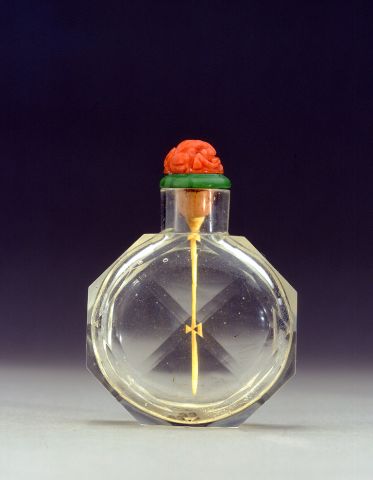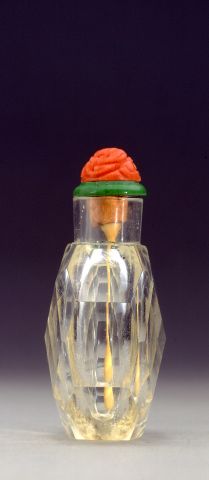

Bottle ID: 00633
CLEAR, OCTAGONAL, RAISED PANELS W/CRIZZLING
Date: 1730-1800
Height: 49 mm
Glass, of flattened octagonal faceted form, with multi-faceted raised panels on the front and reverse, of transparent glass, the interior with extensive crizzling.
Imperial, attributed to the Palace Workshops, Beijing.
Similar Examples:
Hall, Robert. Chinese Snuff Bottles II, 1989, p. 56, no. 38.
Zhang Rong, Luster of Autumn Water, 2004, pp. 286-287, no. 115.
Provenance:
Hugh Moss [HK] Ltd.
Wang Ning, Beijing, December 2004
Exhibited:
Annual Convention ICSBS Toronto, October 2007
In 1696, in the 35th year of his reign, the Kangxi Emperor ordered the building of a glass manufacturing house under the direction of a German Jesuit father, Kilian Stumpf, who had been present at Court since 1695. The Imperial Glasshouse was thus founded to the West of the Catholic Church within the confines of the Forbidden City. The development of glass in China underwent acceleration as the Jesuits passed on their knowledge of glass-making to the Chinese artisans. Very few clearly recognizable pieces of marked Kangxi glass survive today. One well-known piece is the water-pot from the Beijing Palace Museum's Collection. This piece is of faceted form, tapering to a wide mouth, the interior heavily crizzled and with a Kangxi yuzhi mark on its base. It still retains its small rounded cover. It is a unique combination of domestic technique and western style, looking more like a European inkwell than anything else. Faceting, as a shape, can be attributed to the influence of European objects in the Court combined with the preference for Western forms shown by the Jesuits. However, the technique of faceting is clearly Chinese. The water-pot would have been mold-blown, then cut and polished in a similar way to that used by the jade carvers of the time. Faceting in the West was used to show brilliance in glass, gems and crystal, whereas the same effect was not sought after in the East because of a different inherent value placed on glass compared to jade.
The Crane glass bottle, while not as early as the Kangxi water-pot, may date from as early as the Yongzheng period when clear glass was one of the first 'colors' used in the Palace Workshops. It has very extensive crizzling on the interior of the bottle which, although accidental due to excessive alkali in the flux, combines with its slightly yellowish tinge to produce a well-executed imitation of crystal.
< Back to full list
 English
English 中文
中文